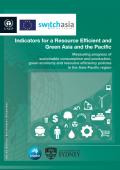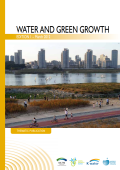Eco-innovation globally emerged as an effort to implement sustainable development. States and firms established and implemented policies and strategies for eco-innovation as one route to achieving sustainable development. Eco-innovation has been facilitated in developed countries, specifically OECD members and European countries, through action plans. Recently, eco-innovation policies have emerged in developing countries. Thus, this study analyzes eco-innovation policies in Asian countries. Policies related to eco-innovation in 17 Asian countries were investigated using policy instrument categories. National policies for eco-innovation were interpreted and compared with development stage classifications. The results indicate that there are similar and different policy approaches to eco-innovation in Asian countries. Given the balance between a technology push (supply side) and a market pull (demand side) in policy instruments for eco-innovation, 17 countries were identified by four categories: leaders, followers, loungers, and laggards. The results provide insight for designing national strategies for eco-innovation in Asia’s developing countries.

Natural resources are the foundation of economic development. This report reveals the patterns and the evolution of natural resource use with 118 indicators in 26 countries of the Asia and the Pacific region over the last 40 years. The analysis shows that resource use in the region is both inefficient and unsustainable. The Asia-Pacific region will not be able to base its future economic growth on declining costs of natural resources as was possible during most of the twentieth century. An increasing reliance on resources from abroad and volatility in the global resource markets will pose challenges to the economic resilience of countries in the region. In this new economic context resource efficiency and decoupling of economic growth and resource use will be fundamental to the economic success of the region. The knowledge generated by this report helps to improve the understanding of the natural resource use and emissions consequences of economic growth in Asia and the Pacific to support policy formulation, monitoring and policy evaluation in the countries of the region.

This report is the first major output of a project on Water and Green Growth, led by the Government of the Republic of Korea and the World Water Council (WWC). It is the result of over 12 months of research and analysis by an international group of experts. It provides an analysis of 26 case studies that illustrate various aspects of water and green growth, and then uses the analysis to recommend a draft framework for policymakers.
This paper considers the extent to which the Northeast Asian countries - China, Japan, South Korea, and Taiwan - are collaborating as a legitimate group to produce “green” R&D. Forcing a revision of traditional institutional analysis, such collaboration efforts can overlap with existing policies of regional coordination, but they can also pave the way for future, formal coordination efforts. Employing a mixed methods approach which triangulates data based on expert interviews as well as green patenting output over the last 33 years, it is confirmed here that the presence of the Northeast Asian environmental regime is strongly associated with the development of green R&D among countries in the region. It can be further confirmed that Northeast Asia is on the cusp of becoming a genuine counterweight to the existing dominance of the U.S. and Western Europe.
In the first dispute on renewable energy to come to World Trade Organization (WTO) dispute settlement, the domestic content requirement of Ontario’s feed-in tariff was challenged as a discriminatory investment-related measure and as a prohibited import substitution subsidy. The panel and Appellate Body agreed that Canada was violating the GATT and the TRIMS Agreement. But the SCM Article 3 claim by Japan and the European Union remains unadjudicated, because neither tribunal made a finding that the price guaranteed for electricity from renewable sources constitutes a ‘benefit’ pursuant to the SCM Agreement. Although the Appellate Body provides useful guidance to future panels on how the existence of a benefit could be calculated, the most noteworthy aspect of the new jurisprudence is the Appellate Body’s reasoning that delineating the proper market for ‘benefit’ analysis entails respect for the policy choices made by a government. Thus, in this dispute, the proper market is electricity produced only from wind and solar energy.
